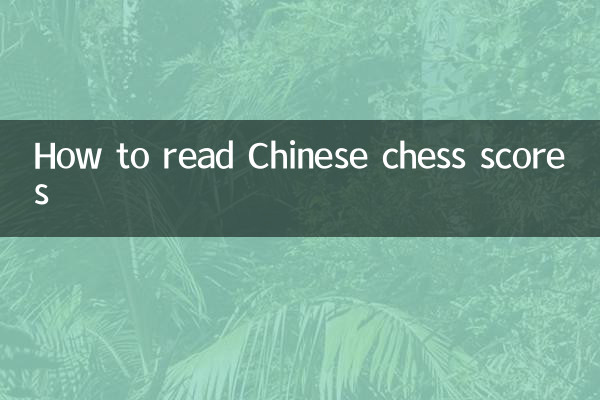How to read Chinese chess scores
In the past 10 days, Chinese chess has once again become a hot topic on major social platforms and news websites. Whether it is the fierce showdown in the National Chess Championship or the latest breakthroughs in AI chess software, they have triggered extensive discussions. For many chess enthusiasts, how to read chess records is a basic but important skill. This article will introduce in detail the basic rules and interpretation methods of Chinese chess records, and attach structured data to help readers quickly master it.
1. The basic composition of Chinese chess records

Chinese chess records record every move in the game and usually consist of the following parts:
| components | illustrate |
|---|---|
| Number of rounds | Indicates the current step. The red side and the black side each move one step for one round. |
| Chess piece name | Expressed in Chinese characters, such as "car", "horse", "cannon", etc. |
| location marker | Use numbers or positional words to indicate the moving position of the chess pieces |
For example, "cannon two draws five" in the game record means that the red side's cannon moves from the second lane to the fifth lane.
2. Position marks in chess records
The Chinese chess board consists of nine vertical lines and ten horizontal lines. The vertical lines are called "roads" and the horizontal lines are called "rows". The perspective of red and black is different, so the position marks in the game are also different:
| mark | meaning | Example |
|---|---|---|
| flat | Lateral movement | Cannon two draws five |
| Enter | Move forward (up for red, down for black) | The car comes in |
| retreat | move backward | Horse eight retreats seven |
3. Naming and moving of chess pieces
There are seven types of Chinese chess pieces. The moves and naming rules for each type of chess piece are as follows:
| piece | Moving rules | Naming example |
|---|---|---|
| General/Commander | Can only move within the nine-square grid, one step at a time | Add five to one |
| scholar/official | Walking diagonally is limited to the nine-square grid | Scholars advance from fourth to fifth |
| image/phase | You can't cross the river by walking on the word "field" | Three elephants retreat five |
| car | Walk in a straight line, no limit on the number of steps | One car and two cars |
| horse | If you use the word "日", you may be lame. | Horse two into three |
| gun | Walking in a straight line, you need to take one piece apart to eat. | Cannon two draws five |
| soldier/pawn | You can only move forward before crossing the river, but you can move left and right after crossing the river. | Seven soldiers advance to one |
4. Analysis of actual chess records
The following takes a simple actual chess record as an example to help readers understand the interpretation method of chess records:
| round | red square | Black |
|---|---|---|
| 1 | Cannon two draws five | Horse 8 into 7 |
| 2 | Horse two into three | Car 9 flat 8 |
| 3 | One car and two cars | Cannon 8 into 4 |
This piece of chess record shows: the red side moves the cannon from the second lane to the fifth lane in the first step, and black vaults to the 7th lane; the red side vaults to the 3rd lane in the second step, and the black square moves the rook to the 8th lane; in the third step, the red square moves the rook to the 2nd lane, and the black square cannon enters the 4th lane.
5. How to quickly master chess records
For beginners, understanding chess records requires some practice. Here are a few suggestions for quickly mastering chess:
1.Familiar with chessboard coordinates: First remember the number of each vertical line (red squares are 1-9 from right to left, black squares are 1-9 from left to right).
2.Watch more actual battles: Learn by watching expert games or chess teaching videos and comparing them with chess records.
3.Use chess software to assist: Many chess software can display chess records and game changes in real time to help understanding.
4.Practice more frequently: Try to record the game yourself or review classic chess games to gradually increase the speed of interpretation.
With the development of AI technology, many chess software can now also provide analysis and suggestions of chess records, providing more convenience for enthusiasts to learn chess records. Recently, the upgraded version of the chess AI "Jue Yi" has once again become a hot topic, which also reflects the new development of chess under modern technology.
Mastering the interpretation method of chess records can not only help enthusiasts learn chess better, but also deeply appreciate the exquisite games of masters. I hope this article can provide you with clear guidance and help improve your chess level.

check the details

check the details